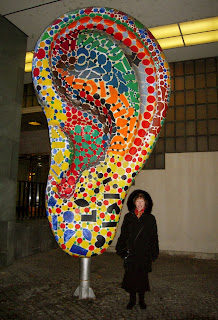
Every day between November 29 and December 24, we passed by (and occasionally patronized) sturdy and beautifully decorated punch stands as early as noon, and as late as 10 in the evening. We visited punch stands operated by philanthropic organizations, museums, churches, and restaurants. Never did we see a punch stand that wasn’t actively dispensing punch; families, couples, and huge knots of friends lingered and laughed whilst partaking of punch. There was demand and there was supply – plenty of hot, fortified, beverage to go around. As the Jesuit priest enthusiastically said in his invitation to the whole congregation after his Midnight Mass benediction, “Come! Drink punch with us. This will warm you. And believe me, we Austrians know a thing or two about how to get and stay warm.” Well, to that, we say “Amen, Brother.”
What is punch, you might ask? Well, it depends on the type you are sampling; the one constant, though, is hot booze. Most often the essential ingredient is wine (usually red, sometimes white), however sometimes apple cider is used as a base. The base is then flavored with a little sugar and spices such as cinnamon or cloves, and occasionally extra liquors such as schnapps or kirsch are added. We saw signs pushing “turbo punch” but frankly, we were a little apprehensive about what that might mean, so we didn’t imbibe. Most punch stands also offered “kinder punch” for the little nippers.
In Austria, a firm rule seems to be, “where there is good drink, there must be good food.” Weihnachtsmarkts are no exception. The variety of cuisine, both savory and sweet was always impressive. During Advent we strolled through Weihnachtsmarkt mazes of food vendors selling pretzels, waffles, würstel, roasted nuts, cookies, sandwiches, baked potatoes, macaroni dishes, pancakes, doughnuts, candy apples, cotton candy, smoked meats, knödel, cheese, bread, corn on the cob – and of course, hundreds of varieties of chocolate and candy. But in the constellation of Weihnachtsmarkts foods, we feel the shining star is the made-from-scratch Kartoffel Puffer (pronounced “poofer”). Imagine grandma’s famous shredded potato pancake batter deep-fried in front of your eyes. Your Puffer is then gently pulled from the hot oil, sprinkled with salt, and placed in your gloved hand. The Puffer is crispy on the outside, and incredibly tender and well, poofy, on the inside. We did our part to sample Puffers across the city. Ladies and gentlemen, the hands-down winner is the Spittelberg Adventsmarkt Kartoffel Puffer stand, just a five-minute walk from our apartment – a Christmas wish come true!


























































